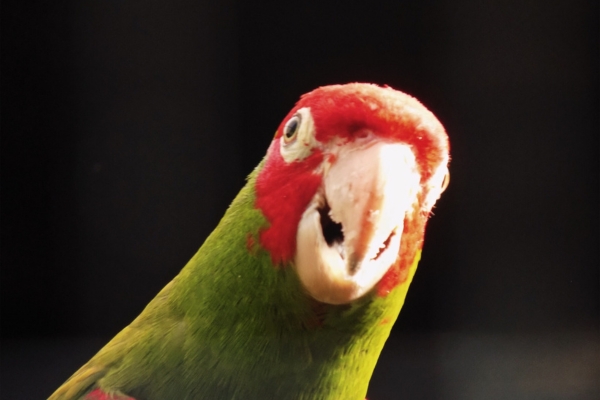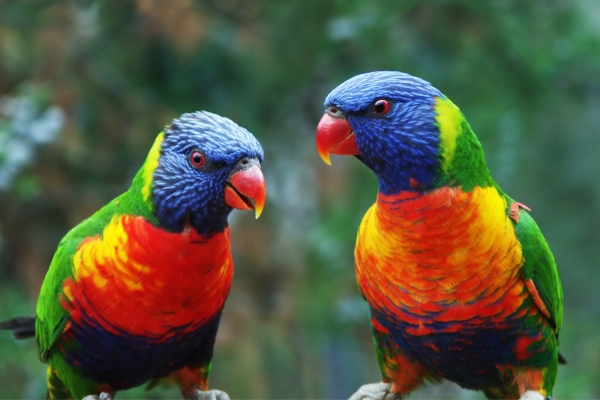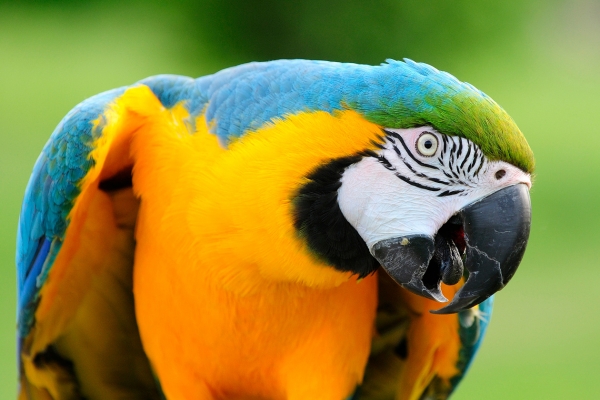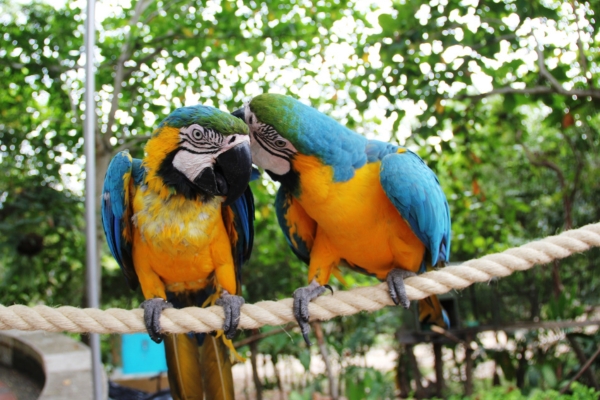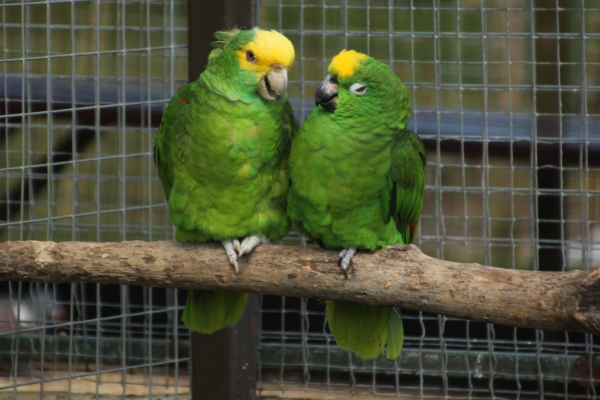Many parrot species are renowned for their exceptional ability to mimic human speech. African grey parrots, Amazon parrots, cockatoos, budgerigars, and cockatiels rank among the top talkers that stun owners with their extensive vocabularies.
Teaching these intelligent birds to talk remains a beloved pastime among parrot enthusiasts. When continuously engaged through incremental training techniques, parrots can realistically master dozens of words and phrases to showcase during playful interactions.
If you recently welcomed one of these chatty species into your home, this guide covers everything required to nurture their speech successfully. Follow our tips below on selecting a candidate, understanding the speech process, troubleshooting challenges, and extending their verbal repertoire to help your parrot find its voice.
Choosing a Parrot with Talking Potential
While the majority of parrots possess some capacity for vocal mimicry, certain species outshine others regarding clarity, vocabulary range, and eagerness to replicate. Top-ranking talkers include:
1. African Grey Parrots
Renowned as the gold standard, African greys stand among the most proficient mimics across all bird species. Their exceptional intelligence, lifelong curiosity, and incredible memory allow greys to master hundreds of words used appropriately in context.
2. Amazon Parrots
From spirited yellow napes to adorable senegals, Amazon parrots rate among the largest and most popular pet parrots. All subspecies showcase excellent talking potential thanks to immense brainpower matched with clownish personalities.
3. Cockatoos
Despite notorious noise levels, cockatoos like Goffin’s and umbrellas make first-rate speech students. Their impressive ability to model intonation and inflection helps them master phrases beyond straightforward words.
4. Cockatiels
Though petite, these pint-sized parrots often surprise owners with clearlyspoken additions to their vocabularies. While limited in words compared to larger parrots, cockatiels still make delightful dilute conversation companions.
5. Budgerigars
Common pet store budgies display untapped talking talents through persistence seldom showcased. Though vocabulary remains limited to a handful of words, their diminutive size makes each one more astonishing.
While vocal parrots make ideal speech pupils, also assess individual personality indicators of talking potentials like confidence, playfulness, and bonding when selecting candidates. Shy, anxious, neglected, or abused parrots struggle to open up enough to explore mimicking. Seek well-socialized fledglings hand-fed for optimal development.
Understanding Parrot Speech Skills
Before attempting complex conversational cues, first comprehend precisely how parrots produce human speech physiologically.
1. Physical Speech Components
Parrots lack vocal cords and lips. Instead, they rely on the syrinx organ located at bifurcations in their tracheas. Containing membranes and muscles, syrinx structures act akin to vibrating vocal cords to replicate sounds.
Parrots then utilize their tongues and beaks to further manipulate noise into recognizable words and phrases. Such anatomical differences account for trademark raspy voices and whistle-like pitches.
2. Cognitive Factors
Mimicking speech relies on a parrot’s innate flocking instincts. In the wild, parrots continuously expand contact calls shared amongst their colonies. Thus in captivity, parrots identify talking humans as fellow flock members, striving to participate through imitation.
Their exceptional brains also allow parrots to memorize and contextualize hundreds of words through association versus merely parroting without comprehension. However, frustration often arises when caretakers expect perfect pronunciation and grammar versus embracing playful vocal experimentation.
Step-By-Step Speech Training Techniques
With biology and mentality now understood from your parrot’s perspective, explore our blueprint towards nurturing their maximum speech potential through incremental steps.
Step 1: Establish Strong Bonds
A parrot will only attempt to mimic flock members they know and trust intimately. Therefore concentrate first solely on relationship building instead of speech training through:
- Generous praise and affection during interaction
- Consistent morning and bedtime routines
- Positive reinforcement training for foundational behaviors
Gradually introduce targeted speech attempts only once your parrot eagerly anticipates time spent bonding.
Step 2: Encourage Vocalizations
Before tackling specific vocabulary, inspire vocal practice encouraging parrots to flex their syrinx muscles.
- Pique their innate curiosity about unfamiliar noises by playing sound clips of instruments, sirens, or animal calls.
- Whistle or sing around your parrot frequently so they grow comfortable adding their voice.
- Mimic your parrot’s contact calls, inspiring them to replicate back more complex replies.
Celebrate all their cooing, chirping and squawking attempts even if not yet polished words. Fostering vocal confidence and playfulness remains key at this introductory phase.
Step 3: Name Common Objects
Capitalize on your parrot’s high intellect by applying their inherent ability to categorize elements of their environment. Enrich their cage and play areas with 5 to 10 items, consistently naming each one when interacting to create strong associations through repetition.
Great beginner options include labeling:
- Favorite toys and playgrounds
- Command cues like “step up” and “come here”
- Family and flock members’ names
- Rooms they frequents like “kitchen” and “playroom”
React with appropriate and lavish reactions whenever they attempt mimicking to affirm their speech efforts.
Step 4: Expand Expressions in Context
Once your parrot reliably names objects in their surroundings, broaden their talking horizons by introducing situational expressions used naturally in applicable settings.
Examples include:
“Peekaboo” when uncovering hiding parrots
“Hello” and “Goodbye” during arrivals and departures
“Yummy” when feeding beloved treats
“Bedtime” when returning them to cages at night.
Again, consistently reward all efforts with suitable responses and enthusiasm to fuel their eagerness.
Step 5: Host Talk Time Sessions
Now set aside short 5 to 10-minute intervals specifically for speech training by reinforcing recently acquired vocabulary and continually introducing new words.
Help instinctual flock member traits emerge further by engaging parrots conversationally through:
- Asking known questions like “Wanna go play?” and praising replies
- Adding a second “conversation” parrot to demonstrate exchanges
- Role playing scenarios that invite commentaries like “uh oh!” or “yum”.
Conclude each talk time on the highest praiseworthy note to generate anticipation for the next chat.
Troubleshooting Talk Training Challenges
While the above blueprint sets the stage for stellar speech students, hit snags occasionally arise demanding specialized troubleshooting interventions.
1. Lackluster Interest
If your parrot responds apathetically or avoids vocalizing outright, reassess foundations. Stress, neglect, loneliness or health issues overshadow speech curiosity. Alternatively, ultra timid temperaments may require even slower acclimation to communicating through speech versus flock calls.
2. Persistent Mispronunciations
Don’t over-scrutinize accurate pronunciation or grammar early on. Parakeets for example may struggle ever producing certain letters due to syrinx limitations. Instead, focus on the incredible acoustic and cognitive feats achieved as they interpret mouth and tongue motions utterly foreign.
3. Talkativeness Plateaus
Avoid assumptions that parrots sporting 100 plus word vocabularies should continually progress exponentially. Their speech necessarily shifts focus from quantity to precision strengthening newly incorporated words through contextual usage.
4. Mimics Other Noises
Parrots often pick up environmental sounds like doorbells effortlessly while still struggling with speech. Clean speech relies extraordinarily on you providing well-enunciated models. Record your voice to identify mumbling that inadvertently highlights irrelevant noises instead.
5. Regression After Illnesses/Stressors
Just like human languages, parrots’ hard-won verbal repertoires remain exceptionally fragile. Regressions after health issues or major lifestyle changes are emotionally taxing but rarely permanent. Simply return to basics through bonding and vocabulary rebuilding until confidence returns.
While troubleshooting talking troubles takes patience, understand your parrot is equally if not more frustrated in their speech journey. Counter with compassion through supportive guidance and their vocal abilities will ultimately triumph.
Expanding Advanced Speech Skills
Once fundamental speech milestones manifest reliably, parrots enjoy showcasing ever sophisticated verbal talents given continual nurturing. Widen talking horizons even further through:
1. Longer Phrases
String together frequently utilized words like “Come here buddy” and “Go play now” to encourage sentence-like structures beyond one-word demands.
2. Song Lyrics
Those musically inclined parrots may astonished you belting their favorite tunes. Nurture talents by selecting short repetitive verses without tricky notes as ideal starting melodies.
3. Sound Effects
Elevate their comedic timing by training funny reactionary sound bites like gasps, evil laughs and raspberries.
4. Multiple Languages
Introduce alternate languages like Spanish for bilingual brains. Stick with the same words between languages focusing on concepts already mastered in English first.
5. Simultaneous Duets
Add “duet time” challenging parrots to harmonize with caretakers or recordings to uncover striking sopranos.
As you continually structure vocabulary building as rewarding games, adolescent parrots retain lifelong zeal in tackling talking challenges through their senior years. Avoid impatient expectations, instead simply marvel in their incredible communications curiosity. Soon, you’ll converse with the most captivating conversational companion imaginable.

